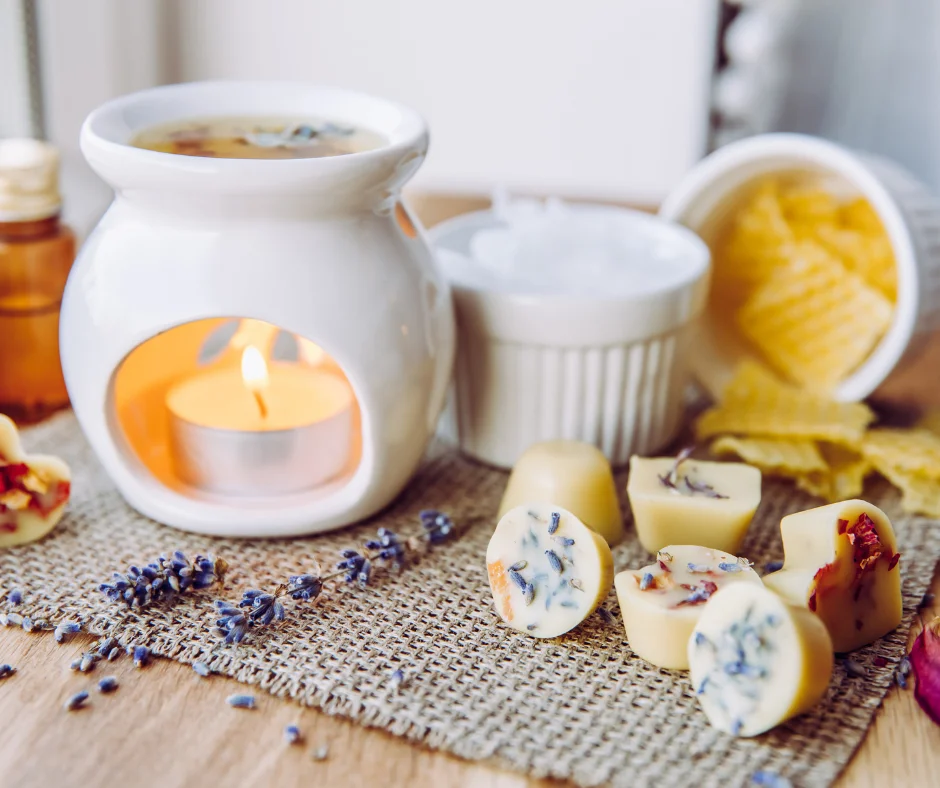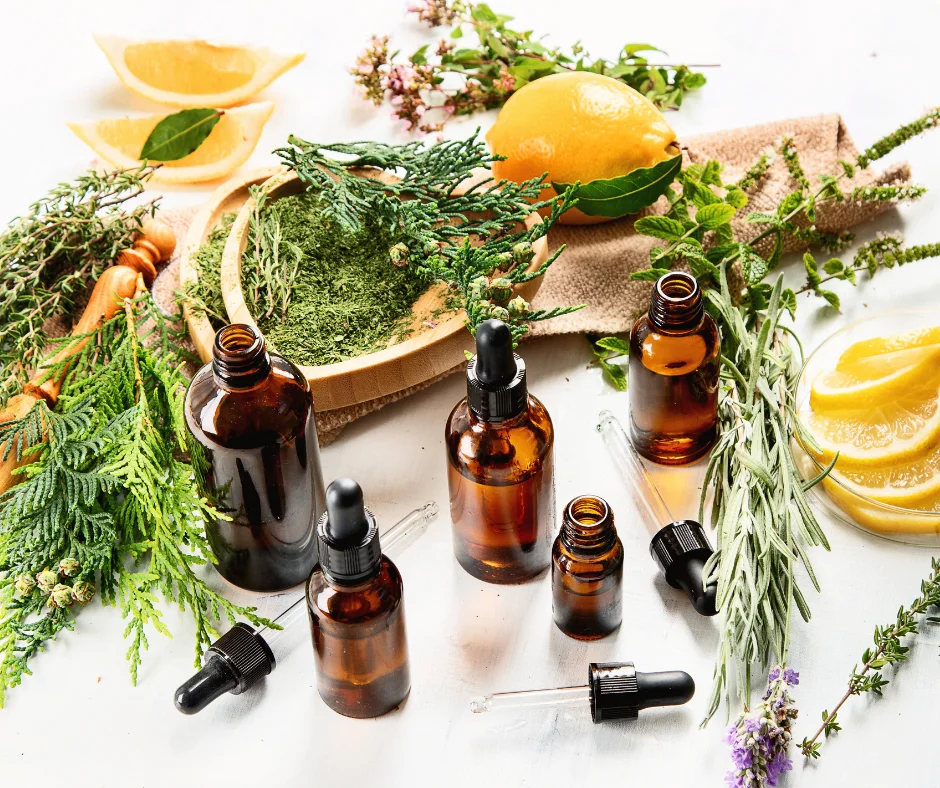Many people wonder if they can put essential oils on a wax burner. This blog will cover everything you need to know about using essential oils in a wax burner. We will talk about the different types of wax burners available and how to use them safely with essential oils. We will also give you some tips on choosing the right essential oils for your needs.
In general, essential oils can be used in wax burners as an alternative to reed and oil diffusers. You need to add diluted essential oil to the wax warmer dish and heat it with an electrical wax warmer. Do not use an open flame to heat your essential oil.
We recommend the use of oil and reed diffusers over the use of wax burners. Wax burners are designed for wax but can be used as an alternative if you do not have an oil of reed diffuser.
We will now cover the different types of wax burners that you can use with essential oils and how you can safely use essential oils with your wax burners and warmers.

What are wax burners and melters?
Wax burners, also known as wax melters, are electric devices that slowly melt wax cubes or pellets, releasing their fragrance into the air. Many people enjoy using wax burners because they can be used with various waxes and oils, allowing you to customise your fragrance experience.
What are essential oils?
Essential oils are natural, concentrated extracts from plants. Unlike fragrance oils, which are artificially created, essential oils contain the plant’s natural aromatic compounds. Essential oils have many benefits, including reducing stress and promoting relaxation.
How to add and dilute essential oils for wax warmers and burners?
When using essential oils on a wax burner, using water is necessary. This is especially important when using a wax burner, as essential oils can be very concentrated, cause skin irritation, and are highly flammable.
Another essential thing to keep in mind when using essential oils in a wax burner is that not all oils are suitable for use with heat. Some essential oils, such as citrus oils, can degrade when exposed to heat, so it’s necessary to check whether an oil is heat-safe before using it on a wax burner.
Generally, essential oils with a fresh, clean scent are best used on a wax burner. Some of the most popular essential oils used in wax burners include lavender, eucalyptus, and peppermint.
How much essential oil should I add to the wax burner dish?
When diluting your solution a few drops of essential oil should be enough to receive the benefits and circulate fragrance around your home. Do not exceed 10 drops of essential oil within your wax burner dish. The diluted solution of water can become too concentrated and can cause a fire risk. You want to ensure that you only add enough to fell the benefits – so do so gradually.
What wax warmers can you use with essential oils?
Using essential oils in a wax burner is a great way to enjoy the benefits of these oils while filling your home with a pleasant fragrance. Here’s everything you need to know about using essential oils in wax burners.
There are three main types of wax burners: electric, tealight, and plug-in.
Electric wax burners are the most common type of wax burner. They come in various shapes and sizes and can be used with essential oil. Add a few drops of essential oil to water and mix the combination. Add the mixture to the dish and turn on the burner to use an electric wax burner.
Tealight wax burners are another popular type of wax burner. They are usually made of ceramic or metal. With these types of wax burners, it is not recommended to use essential oils as there is a risk of fire with an open flame. As stated, essential oils are highly flammable, and the oils must not come in contact with open flames.
Robert Tisserand, a world leading expert in the field of aromatherapy, states that:
Where there have been problems is with burner/vaporizers that use a naked flame candle – these have been known to “spontaneously” catch fire, and they are a fire hazard. When a naked flame comes into direct contact with concentrated essential oils and a very hot burner, sometimes with oily residues, this can be a risk. Much better to use ones that operate without a naked flame.
Robert Tisserand
Plug-in wax burners are the third type of wax burner. They are similar to electric wax burners, but they plug into an outlet instead of using a battery. Plug-in wax burners can be used with any essential oil. Add a few drops of essential oil to water and mix the combination. Add the mixture to the dish and turn on the burner to use an electric wax burner.
Now that we have covered the different types of wax burners, let’s talk about how to use essential oils with your wax burner safely.

How to safely use essential oils with your wax burner
There are a few things to keep in mind when using essential oils with your wax burner:
Always dilute your essential oil before adding it to the wax burner dish. When diluting essential oils, it is necessary to use water to dilute the solution.
Secondly, make sure not to spill the essential oil as it can irritate your skin.
Never leave your wax burner unattended while it is on. Essential oils are volatile and will evaporate, and you must not carry out a “dry burn” where there is nothing to burn in your melt dish. This is a fire hazard, so ensure you monitor your wax burner.
Be sure to follow the instructions with your wax burner. If the instructions state only to use a specific type of wax or oil in your wax burner, then follow the instructions and do not use essential oils. The manufacturer knows best in these situations as they know the product’s design intent and have tested their solution.
Benefits of using essential oils over fragrance oils and wax melts
There are many benefits to using essential oils over fragrance oils and wax melts. One of the main benefits is that essential oils are natural and not synthetic like fragrance oils. Essential oils are also less likely to irritate when used on a wax burner.
Another benefit of using essential oils over fragrance oils and wax melts is that they can provide therapeutic benefits. Some essential oils, such as lavender oil, help with anxiety and stress.
Different essential oils provide additional benefits. We list a few below:
Eucalyptus – good for sinuses
Lavender – good for anxiety and stress
Peppermint – good for headaches
Cedarwood – good for concentration
Rosemary – good for memory
Bergamot – suitable for uplifting moods
If you want to know more about essential oils that you should not mix together, hold up for just a minute. We wrote an article all about oils that you should not mix together that we encourage you to read!
These are only a few of the essential oils that you can use, and there are thousands of different combinations that you can make. Combining two or more oils is called synergy and can create an even more powerful effect. You must be careful with the combinations; however, as many mixes can cause an unpleasant smell and will not synergise together.
Using essential oils in a wax burner is a great way to enjoy the benefits of these oils while filling your home with a pleasant fragrance. Follow the instructions above and be sure to check the essential oil.

Wax burner alternatives for diffusing essential oils
There are a few alternatives to using wax burners for diffusing essential oils. These methods are specifically designed for essential oils unlike wax burners. The clue is in the name, wax burners are designed for wax but if you choose to use essential oils – do so safely. One is to use an oil diffuser:
An oil diffuser is a device that disperses essential oils into the air. Oil diffusers come in many different shapes and sizes. Some oil diffusers are electric, while others use heat or ultrasonic waves to disperse the oil.
Another alternative is to add a few drops of essential oil to a pot of boiling water. The steam will carry the essential oil into the air and diffuse the scent throughout the room.
You can also use a reed diffuser. Reed diffusers use reeds to diffuse the essential oil into the air. The reeds are placed in a bottle of essential oil and left to diffuse the oil into the surrounding area.
Final Thoughts
If you’re looking for a way to enjoy the benefits of essential oils while filling your home with a pleasant fragrance, using essential oils in a wax burner can be an alternative to reed and oil diffusers. Just be sure to use a water to dilute the essential oil and check that the oil is suitable for use with heat before adding it to the wax. Ensure that no open flames are present in the process of heating your essential oil.
Now that you know everything you need to know about using essential oils in a wax burner try it out! Choose the right essential oil for your needs and enjoy the benefits of aromatherapy. Thanks for reading!
What are some of your favourite essential oils in a wax burner? Let us know in the comments below!
Do you have any tips on using essential oils in a wax burner? Please share them with us in the comments below!
If you found this blog post helpful, share it with your friends! Thanks for reading!
We hope you enjoyed this blog post. If you have any questions, leave them in the comments below. Thanks for reading! Until next time!


